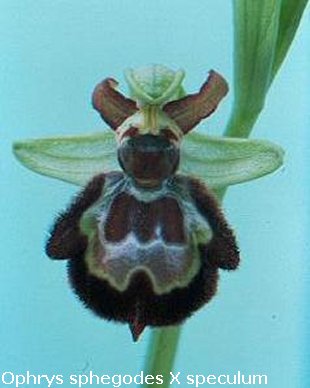Ophrys
|
Comments to the offered plants:
Ophrys heldreichii. A large flowered and
beautiful Ophrys. Frost hardy up to -6°C.
Ophrys lutea. The true
Ophrys lutea from the westmediterranean region. Easily distingished
from closely allied species by its lemon scent. Frost hardy up
to -4°C.
Ophrys reinholdii. Large and very dark flowers on tall stems. Frost hardy up to -6°C. Ophrys apifera-hybrids. Very beautiful and fairly easy to grow. Most Ophrys apifera-hybrids are frost hardy up to -10°C. Ophrys sphegodes-hybrids. Fairly easy to grow. Often with a large labellum und very beautiful. Most Ophrys sphegodes-hybrids are frost hardy up to -12°C. Ophrys insectifera-hybrids. V ery beautiful and fairly easy to grow. Ophrys insectifera is very often the dominant parent in flower shape. The size of the labellum is intermediate between the parents. Ophrys insectifera-hybrids are frost hardy up to -12°C. Ophrys fuciflora-hybrids.
Ophrys fuciflora inherits its large flower, otherwise the
hybrids are much closer to the other parent. It seems to be genetically
recezive. Frost hardy up to -10°C.
Ophrys sphegodesXspeculum. Large
beautiful lip and fairly easy to grow. Frost hardy in the F1.
Selected plants have been back crossed to O. speculum. The
frost hardiness of the back cross is still unknown.
Ophrys insectiferaX speculum. A very
beautiful lip. Frost hardy and fairly easy to grow.
Ophrys fuciflora X heterochila. Early flowering, in the garden from end of April. Flowers similar to O. heterochila, but much larger. Often clonal like O. heterochila. Not very variable. Ophrys apifera X reinholdii.
Large dark flowers, looking like
bees. Flowers in the garden from the end of Mai to end of June.
|
Distribution: Description: Culture: Recommended potting mixes: Further reading:

|
||||
 |

|
© 2000-2010 Heinrich Beyrle





